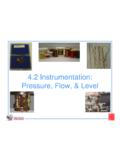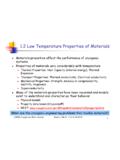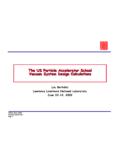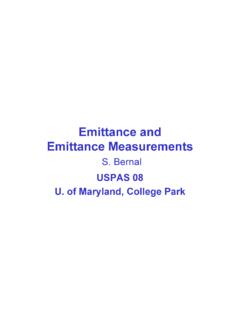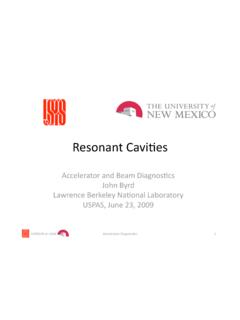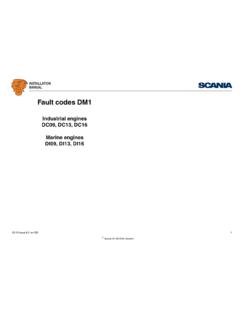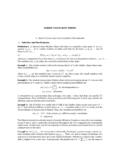Transcription of Impedance Matching and Smith Charts - Fermilab
1 Impedance Matching and Smith ChartsJohn Staples, LBNL Impedance of a Coaxial Transmission LineA pulse generator with an internalimpedance of R launches a pulsedown an infinitely long coaxialtransmission though the transmission line itself has no ohmic resistance, a definite current I is measured passing into the line by during the period of the pulse with voltage Impedance of the coaxial line Z0 is defined by Z0 = V / Impedance of a coaxial transmission line is determined by the ratio of the electric field E between the outer and inner conductor, and the induced magneticinduction H by the current in the surge Impedance is, where D is the diameter of the outer conductor, and d is the diameter of the innerconductor. For 50 ohm air-dielectric, D/d = 0 0ln Dd =60ln Dd Z0= 0 0=377ohmsis the Impedance of free space. Velocity of Propagation in a Coaxial Transmission LineTypically, a coaxial cable will have a dielectric with relative dielectric constant erbetween the inner and outer conductor, where er = 1 for vacuum, and er = a typical polyethylene-insulated characteristic Impedance of a coaxial cable with a dielectric is thenand the propagation velocity of a wave is,where c is the speed of lightIn free space, the wavelength of a wave with frequency f isFor a polyethylene-insulated coaxial cable, the propagation velocity isroughly 2/3 the speed of r60ln Dd vp=c r coax=1 rcf= free space r Reflection from End of a Shorted Transmission LineInstead of an infinitely long transmission line, consider a finite length thatis terminated by a short circuit.
2 At the short, the voltage is zero. This boundary condition can be satisfied by imagining a negative pulse coming from the right, overlapping the forward pulse as it encounters theshort, and continues on to the left toward the the time it takes to propagate the pulse down the line is tp, then the invertedpulse arrives back at the generator at time 2 tp. Note that the generator has an internal Impedance R. If R = Z0, the returningpulse is completely absorbed in the generator, as the transmission line isterminated in its characteristic Impedance Z0. Reflection from End of an Open Transmission LineInstead of an infinitely long transmission line, consider a finite length thatis terminated by an open circuit. At the open, the current is zero. This boundary condition can be satisfied by imagining a positive pulse coming from the right, overlapping the forward pulse as it encounters theshort, and continues on to the left toward the the two pulses overlap as two batteries of identical voltage:No current flows as the voltage on eachbattery is the pulse from the generator returns in time2 tp with the same polarity as original.
3 Input Impedance of a Transmission Line with Arbitrary TerminationThe Impedance at the entranceof a transmission line of length Land terminating Impedance ZL isZi=Z0ZL jZ0tan LZ0 jZLtan L,j= 1where b is the propagation constant =2 fc r=2 rThere are three special cases, where the end termination ZL is an open ora short circuit, or a termination resistance equal to the characteristic Impedance Z0of the transmission line will introduce the Smith Chart later, which simplifies the calculation of Zi foran arbitrary terminating Impedance . Special Cases of Terminating ImpedanceZL = 0 (short circuit) Zi = Z0 j tan b L = 0, L = l/2, l, .. = infinite, L = l/4, 3l/4,..ZL = infinite (open) Zi = -Z0 j cot b L = infinite, L = l/2, l, .. = 0 , L = l/4, 3l/4.
4 ZL = Z0 (matched) Zi = Z0 The shorted or open line is always reactive (like a capacitor or inductor), andreflects the terminating Impedance for integrals of a half wavelength, and theconjugate of the terminating Impedance for odd terminated line Impedance is independent of the frequency or length ofline (assuming a lossless transmission line). Special Use for a Quarter-Wave StubZL = 0 (short circuit) Zi = Z0 j tan b L = infinite, L = l/4, 3l/4,..A shorted stub transforms to an infinite Impedance at odd multiples of a quarter quarter-wave stub is a convenient wayof supporting an inner conductor withoutan insulator, and accessing the innerconductor with water cooling, for are also used in Matching a load toa source by introducing an intentionalreflection. Reflection CoefficientThese terms are used to describe the ratio of the voltage (at one frequency) launcheddown a transmission line and the voltage reflected back from the far end by amismatched Vf be the forward voltage launched down the line, and Vr the reflected voltage.
5 The voltage reflection coefficient is: , where ZL is the load Impedance and Z0 is the Impedance of the transmission ZL = Z0, there is no reflected wave and G0 = 0. The polarity of Vr reverses for ZL < return loss RL is G0 expressed as a logarithmic quantity: 0 VfVr=ZL Z0ZL Z0RL= 20log10 0 RL = -infinite dB for a matched load. At a given frequency f with wavelengtha standing wave will exist on the transmission line (if a reflected wave exists).The forward and reverse waves will interfere with each other and produce a stationarypattern of the envelope. The Voltage Standing Wave Ratiois the ratio of the maximum tothe minimum amplitude of thestanding waveand is usually expressed as a ratio, such as VSWR = 3:1. In terms of the reflection coefficient:If VSWR = 1, G0 = 0 (no reflection) =vpf,vp=c 1 VSWR=1 0 1 0 Voltage Standing Wave RatioVSWR = Voltage Standing Wave Ratio (sometimes just called SWR)Standing wave with envelope variation Transformation of Arbitrary Impedance LoadDefine a normalized Impedance : ZL and Z0 are the load and line Impedance .
6 The reflection coefficient is where we have expressed the reflection coefficient as a complex quantity. and b is the propagation constant of a transmission input Impedance of a transmission line with arbitrary terminating Impedance iszL=ZLZ0 0=zL 1zL 1= ej L =2 fc r=2 r Z =Z01 e 2j L1 e 2j LWe will use the Smith Chart to ease the calculation of this complex quantity. Scattering MatrixIn the RF (microwave) domain, it is difficult to probe the voltages and currents invarious parts of a circuit, but easier to measure the voltages at given referenceplanes in a circuit. For a linear circuit, we can define a scattering matrix for thecircuit in terms of the incident and reflected voltages at each of the circuit nodes.
7 V1 V2 = S11S12S21S22 V1 V2 where Vi+ are the voltages incident on port i, Vi- are the voltages reflected from port is the reflection looking into port 1, with all other ports terminated in matched V2+ = 0, then S11 = G, the reflection is the voltage transmission coefficient from port 1 to port V1 ,V2 =0S11=Zi Z0Zi Z0,Zi=Z01 e 2j L1 e 2j L S-Parameter Measurements with Network AnalyzerThe network analyzer measuresthe scattering coefficients of atwo-port device type of display is the Smith will use the Smith Chart to calculatea single-stub tuner for a mismatched load. The Smith ChartThe Smith Chart allows easy calculation of the transformation of a complex load Impedance through an arbitrary length of transmission also allows the calculation of the admittance Y = 1/Z of an Impedance is represented by a normalized Impedance around the circle is a line length of Transform a Complex Impedance Through a Transmission LineStart with an Impedance Zi = 27 + 20j ohmsThe normalized Impedance for a 50 ohm line is zi = + jPlot this at point z1.
8 Draw a circle throughthis point around the center. The radius ofthe circle is the reflection coefficient G ,wherethe radius to the edge is A transmission line is wavelengthslong. Draw a line through z1 and the line intersects the wavelength scaleon the outer diameter at l. Add to and draw a new line throughthe center to l. Where the new line intersects the circle, read offthe transformed normalized impedancezf = + j or Zf = 50 + 35 j ohms. Transforming an Impedance to an AdmittanceIt is often useful to find the admittance,the inverse of a given Impedance . y = 1/zA line drawn through an Impedance zto the opposite side of the red circle intersects the value of the Smith chart can be used to find theinverse of a complex quantity. Special Case: Shorted Line StubA shorted transmission linestub will have an impedanceof z = l away it will have anormalized reactance of 0 +1 is inductive reactance.
9 (The upper half of the diagramrepresents an inductive reactance.)1/4 l away it will have a normalized reactance of l away it again has an Impedance of 0.(What happens with an open transmission line segment?) Single-Stub TunerA mismatched load (2-50 ohm resistors in parallel) is to be matched to a pure 50 ohmsat the generator length of line L1 will be varied to presenta 50 ohm resistive part of the complex impedanceat the remainder of the imaginary part will be removed by adjusting the length ofline L2 to cancel out the imaginary that L1 and L2 form a parallel circuit. The formula for adding impedancesin parallel isHowever, the formula for adding admittances is simpler, where y = 1/zWe will use the ability of the Smith chart to calculate admittances and add 1z2ytot=y1 y2 Calculation of a Single-Stub TunerWe will use the Smith Chart to calculate a tuner that matches a 25 ohm resistiveload to a 50 ohm transmission line at 100 normalized Impedance zL = ZL/50 ohms = + 0 j.
10 We can calculate thereflection coefficient G. =zL 1zL 1= this termination is attached to the far end of a 50 ohm transmission lineof length L, the Impedance , looking into the near end, isZi=Z01 e 4 L 1 e 4 L Strategy: first add some line so the real part of the complex Impedance is50 ohms (normalized zi = ). Then add a shorted stub, which providesonly reactance, to cancel out the imaginary part of the complex Impedance ,leaving a pure 50 ohm resistive load. Step 1: Transforming to z = + 0 j : get the real part rightThe normalized Impedance of the 25 ohm resistive load is z = + 0 is point A on the plot. Draw acircle through this point with the centerof the plot as the center. The radius ofthe circle, G = is the reflectioncoefficient for this real part of the complex Impedance = on the green tricky part: we are going to addadmittances, the inverse of Impedance ,so we want to find the length of L1 thatgives the real part of the admittance = is where the red and green circles intersect at point C, and the length of L1 is the angle that gives the Impedance at point B.
